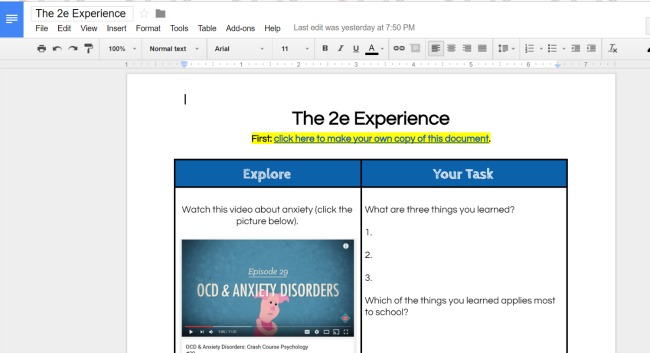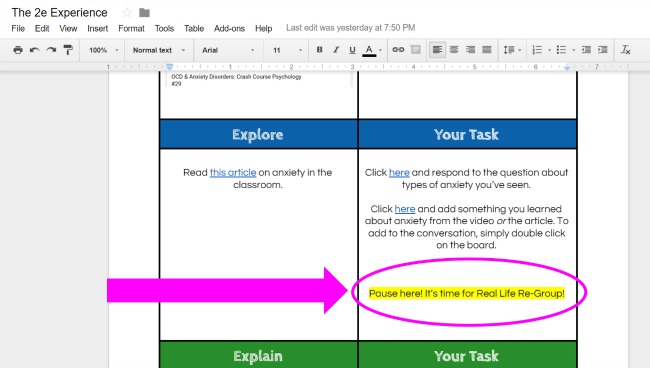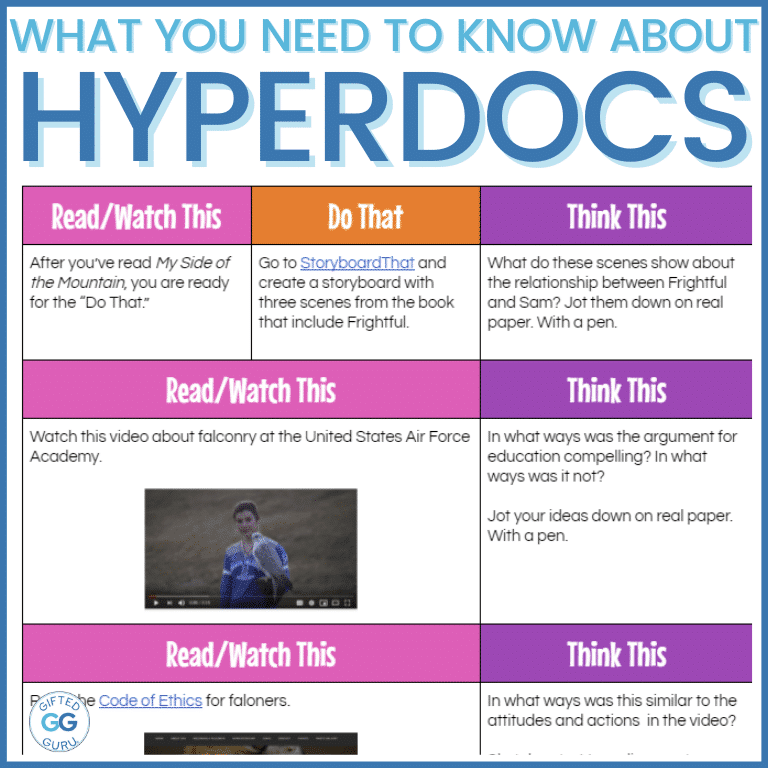This summer I was introduced to a tool I think belongs in every teacher’s toolbox. I decided to try it myself before I shared it with you. I hope you’ll find the tool itself useful, and I also hope you can learn from my story about how I almost rejected a great idea for no good reason.
Meeting Hyperdocs:
I spoke at a gifted event in Bremerton, Washington, where Lisa Highfill, one of the authors of the Hyperdoc Handbook was also a keynote speaker. She generously gave me a copy of the book. [More about that later.]
I had never heard of it before, and I mistakenly thought it was simply a new term for a document with hyperlinks. I was wrong.
A hyperdoc is a digital exchange of ideas among a learning community, facilitated by an online platform such as a Google doc, slide, or other medium. Students engage with material and then participate in activities alone and/or with peers, digitally and/or analog. Stay tuned for more.
After returning from the conference, I read through the book completely, and decided to try it out in a professional development I was creating.
How I Integrated Hyperdocs into My PD:
I was planning a six-hour workshop on 2e kiddos (those who are gifted AND something else, typically what would be called a disability). I was focusing on ADHD, Anxiety, ASD (Autism Spectrum Disorder), and Dyslexia.
I decided to plan a blended model where participants would flow in and out of the hyperdoc and other activities, including direct instruction and discussion.
I divided the day into six (uneven) sections:
- Welcome and introduction to hyperdocs
- Anxiety (hyperdoc)
- Dyslexia (analog, meaning me!)
- 2e Documentary movie and discussion
- ASD (hyperdoc)
- ADHD (analog again)
I created my “normal” type training for the welcome/intro, dyslexia, and ADHD. I created a hyperdoc to for Anxiety and ASD. The 2e Documentary was shown to the whole group, paused for discussion.
We wrapped up with a mini hyperdoc, a quote on a single Google Slide with a link to where ideas were to be shared (the link to the TodaysMeet will only be open a short time).
Where to Start?
I read through the book, and I explored the hyperdocs.co website. I watched videos. I listened to podcasts. I would guess I spent about 20 hours of learning time. The creators of the idea, and all of the teachers in the hyperdocs community, are very, very generous, and there is a lot to explore.
I don’t think everyone needs this much, but I wanted to make sure I didn’t ruin the experience for other teachers, so I had a high expectation of myself. I think a classroom teacher could be up and running with it in just a few hours.
I used two of the templates shared on the site for the training: one for the hyperdoc itself, and one for the “handout.” I used a third for a sharing activity the teachers participated in.
I found the templates super easy to use and adapt. The idea is that you copy the document and then make it your own, crediting the person from whom you got the original.
I called it “The 2e Experience,” and it looked like this:

My Guiding Ideas
- I wanted there to be a variety of things to do and ways to engage, so I had teachers using Menti, a Google Doc, a sticky note parking lot, TodaysMeet, Padlet, and other engagement strategies.
- I wanted to make it very easy to use, yet robust enough that teachers could see what was possible.
- I wanted to make sure no one edited the original document, so I learned how to “force” people to make a copy.
- I wanted to show the ways it could really work for differentiating instruction, so I built in differentiated instruction for the participants.
The Result?
Wow.
It worked. It really worked. With the exception of one participant (ironically, an administrator), everyone was engaged and on task. Very few had technical difficulties (if you don’t count not remembering to bring headphones).
I was shocked at how well it worked, especially because there were about 100 people there, and that’s far more than teachers would have in their classrooms.
Because I wanted a blend of digital and analog, I added in places where teachers were to stop. There were activities to choose from if you got to that point, but you weren’t to continue in the hyperdoc past that point.

You want to see the whole thing, don’t you? I’ve shared it on TeachersGiveTeachers, and you can also get a copy of it here. You can get the handout, too.
I loved hearing teachers exclaiming over all of the things they realized they could do with it. I loved seeing choice in action. I loved everything about how it went.
Pride Before Pedagogy: How It Almost Didn’t Happen
I read about twenty pages of the book the evening Lisa gave it to me, and I almost rejected the entire idea because of a few things:
- I really didn’t care for the foreword. It read as anti-teacher to me, and contained some fairly serious flaws in logic that turned me off like you’d pulled the plug on a toaster. That kind of off.
- There was some misinformation about gifted that bothered me (mostly because I’m a gifted specialist). For example, the book asserts that hyperdocs are a form of acceleration, but they’re not. Acceleration has a specific meaning in Giftedland, and this isn’t it. They’re a differentiation tool, yes, but that’s not the same thing.
- There was some overpromising that grated. For instance, it talks about how everyone can participate in the conversation with a hyperdoc activity, as opposed to a classroom discussion where everyone might not participate. I don’t necessarily agree. Yes, with a hyperdoc everyone’s talking, but that doesn’t mean everyone’s listening. Just because students are all typing something doesn’t mean that communication is really going on. I’m also a superfan of face-to-face discussion.
Those weren’t the things that made me almost reject it, though. That award goes to the conversation Lisa and I had the next day. I shared my discomfort with the foreward (not the other issues), and that did not go over well (#understatement). It isn’t stated in the book, but the foreword I really, really didn’t like was written by her niece. Yeppers.
It was a highly unpleasant experience. I almost simply gave the book away because of it.
How I Humbled Myself and Acted Like a Grown-up
But then, I started thinking about how immature that was. I was ready to reject something that may be a great strategy because I’d had a [very] awkward and uncomfortable discussion with the author. How stupid would that be?
You don’t have to think someone is awesome to think their ideas are awesome. Lisa may indeed *be* awesome. I don’t know. I don’t know her.
And that’s the point. With students, we want them to be open to ideas, even if those ideas come from uncomfortable conversations, from people they don’t really know or like, or even when their feelings are hurt and they’d like to throw the baby out with the bath water.
So I set aside my hurt feelings and jumped in. And I’m super glad I did. I still don’t like the foreword, and I still think it’s incorrect about what it promises for GT kiddos, and I still think that it is too quick to judge analog activities and find them wanting, but I love the strategy and know from personal experience it has tremendous power and potential.
I hope you’ll do the same
I hope you’ll try it. And I also hope you’ll try my idea, too, of being open to ideas from people who challenge you and who think differently from you. Almost always that’s a better idea than assuming that if someone doesn’t like you their ideas are worthless.
I am very glad I tried it. I think it has a place in virtually every teacher’s toolbox o’ tricks. Good job, hyperdocs peeps!




